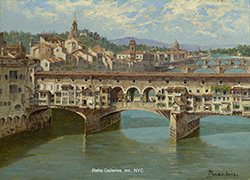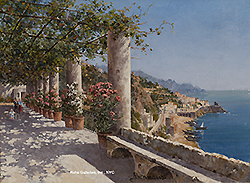BIOGRAPHY - Antonietta Brandeis (1849 - 1926)
Born in the small Bohemian village of Miskowitz on January 13, 1848, Antonietta Brandeis lost her father at an early age, and probably then moved north to Prague with her widowed mother. At some point in the 1860s, she began studying painting with the Czech artist Karel Javůrek (1815-1909). Although nothing is known about the Brandeis family finances during this period, it would have been unusual for a bourgeois young woman to study painting in any serious fashion; this suggests that perhaps Antonietta’s mother was hoping to provide a marketable skill for her daughter in the world of fine art.
During the 1850s-and 1860s, Prague was the center of the Czech National Revival, a cultural movement whose purpose was the rejuvenation of the Czech language as well as the reclamation of a uniquely Czech identity after centuries under the domination of the Hapsburg Empire. Brandeis’s instructor Javůrek seems to have sympathized with this movement, creating history paintings based on Czech–rather than Hapsburg–moments of significance.
Brandeis studied with Javůrek for a brief period, undoubtedly learning the basics of academic painting. It is likely that he also introduced her to the artistic ideas then current in Belgium and France, having studied himself with Gustave Wappers at the Royal Academy of Fine Arts in Antwerp and with Thomas Couture at the Ecole des Beaux-Arts in Paris. This exposure to European Romanticism and Realism would have offered the young Brandeis a sophisticated understanding of contemporary aesthetic issues.
In the late 1860s, Brandeis left Prague and moved to Venice with her mother, who had married a Venetian gentleman. Once there, she enrolled in the Accademia di belle arti (Academy of Fine Arts) studying with Michelangelo Grigoletti, Domenico Bresolin, Napoleone Nani, and Pompeo Marino Molmenti, all of whom were mainstream academic painters. She graduated in 1872 with a number of honors to her credit, and a Premio award in landscape painting. According to the listing in the Atti della reale Accademia di belle arti in Venezia dell’anno 1872, Brandeis was one of only two women graduating that year, the other being Carolina Higgins, an English woman. [i] The admission of women to officially sponsored fine arts academies in Europe and the US was rare in the 1870s, and enrollment in life classes where nude models posed was almost universally unacceptable for female students. The fact that Brandeis and Higgins seem to have been the only women at the Accademia in the early 1870s tends to suggest that they participated in the same classes as their male classmates. In fact, Brandeis is cited for an award in the “study of the nude”. [ii]
After graduation, Brandeis began to establish a career as a landscape painter in Venice. In 1873, she showed four paintings at the annual November exposition at the Accademia; these included one portrait, two landscapes, and one vedute of the Grand Canal that was commissioned by an English woman. Although there is no record of who this English woman was, it is tempting to think that she may have been someone Brandeis met through her classmate Carolina Higgins. [iii]
Over the next few decades, Brandeis seems to have exhibited regularly at the annual Accademia shows, but her primary focus was increasingly on painting Venetian scenes (vedute) that appealed to the always plentiful crowd of visitors to Venice. She specialized in relatively small scale paintings of landmarks in her adopted city, and gradually became part of a community of expatriate artists who shared this interest. Among her friends were the Peruvian artist Federico de Campo and many of the Spanish artists then living in Venice such as Mariano Fortuny, Martin Rico and Rafael Senet. It should be noted too that by the end of the nineteenth century, Venice had become a regular stop for any painter who was particularly fascinated with color and light. Some, like the Americans Walter Gay and John Singer Sargent, spent months or even years living there, and others simply made regular visits, such as Pierre-August Renoir and Claude Monet. However, nearly all painters who traveled through Europe made at least one journey to see Venice’s unique environment.
More important for painters like Brandeis were the travelers who came as tourists and wanted a souvenir to take home with them. By the late nineteenth century the aristocratic tradition of the Grand Tour had been considerably democratized by the industrial revolution, which had not only created a newly wealthy merchant class, but had provided the railroad as a means of convenient travel across long distances. Venice was no longer the exotic province of the European aristocracy, but a city that lured bourgeois romantics from all over the world. Brandeis’s images of the city were especially popular with Austrian and English visitors.
Brandeis also painted at least three known altarpieces, all for churches in what is today southern Croatia. In the late 1870s when she received the initial commission, the Dalmatian coast of Croatia had trading and cultural ties to Italy dating back to the Roman Empire; however, it was the region surrounding the Republic of Venice that was most influential in the nineteenth century. During this time, the new bishop of Split (Spoleto), Marko Kalogjera, was actively involved in building new churches in Croatia as well as updating the older ones, and it is likely that he was instrumental in hiring Venetian painters for a variety of commissions. In fact, Michelangelo Grigoletto, one of Brandeis’s instructors at the Accademia, had earlier received a commission for a painting in a parish church in the town of Vodice. Given the remote location, it is not surprising that Bishop Kalogjera would turn to Venice when hiring artists for major projects in the towns of Blato and Smokvici.
The religious traditions of Venetian painting are clearly evident in Brandeis’s Madonna and Child with St. Vitus at the Church of St. Vitus in Blato. The composition is based on the tradition of the sacra conversazione (sacred conversation) between the Virgin Mary and the saints. In this image, Brandeis presents not only St. Vitus, but also a young man who is apparently suffering from one of the illnesses that the saint was known to cure. The large canvas is surrounded by architectural elements above the altar and creates a dramatic statement as worshippers look up at the elegant Madonna. [iv]
Brandeis also created two paintings for the church of Our Lady of Carmel in the neighboring town of Smokvici. One features another sacra conversazione, this time with St. Lucia, St. Anthony of Padua and St. Roch. The other is an altarpiece showing the Presentation of Christ in the Temple. These three large scale paintings must have been started in 1879 or 1880 and probably finished several years later.
Concurrent with the major altarpiece commissions, Brandeis continued to produce many vedute for travelers in Venice. She also made a number of trips to Florence, Bologna and Rome where she painted cityscapes of the architectural and urban scenes featuring classical and renaissance motifs. The popularity of her work was further enhanced by the production of chromolithographs of her paintings, probably beginning in the late 1880s or 1890s. She expanded her market even further in 1880 when she exhibited three paintings at the International Exposition in Melbourne. In her personal life, Antonietta married Antonio Zamboni on October 27, 1897; Zamboni was a knight of the Order of Saints Maurizio and Lazzaro, originally founded by the Duke of Savoy in 1572, but closely affiliated with the newly united Kingdom of Italy in the late nineteenth century.
Brandeis’s enthusiasm for Venice seems to have waned somewhat by 1900 when she was quoted as saying that she was still “a foreigner” in Venice, and she no longer participated in any Italian exhibitions, but sent all of her paintings to London. [v] Brandeis’s early association with English collectors seems to have evolved into a relationship that served her well for many decades. Nonetheless, she remained in Venice until the death of her husband in 1909, at which time she moved to Florence.
The full story of Antonietta Brandeis’s life remains unknown, but she seems to have been a woman who challenged social conventions on many levels: as a woman studying in an almost exclusively male academy; as a Bohemian-born woman of Jewish heritage working in a Catholic world; and as an expatriate female artist finding friendship among the decidedly patriarchal arts colony of Spanish painters in Venice. After her death in 1926, most of Brandeis’s estate was willed to the Foundling Hospital in Florence (Ospedale degli Innocenti di Firenze), which today remains the primary archive of work. [vi]
Janet Whitmore, Ph.D.
Selected Museums
Gloucester City Museum & Art Gallery, Gloucestershire
Instituto Innocenti, Florence
Museum Revoltella, Trieste, Italy
Pitti Palace, Gallery of Modern Art, Florence
Rossendale Museum, Lancashire County Museums Service, Lancashire
University of Southampton, Hampshire
[i] Atti della reale Accademica di belle arti in Venezia dell’anno 1872, (Venezia: Tipografia del commercio di Marco Visentini, 1872), 62.
[ii] Ibid.
[iii] Elenco degli oggetti d’arte ammessi alla esposizione nelle sale della R Accademia Veneta di belle arti, (Venice: Accademia Veneta di belle arti, 1873),12. Catalogue numbers 125, 126, 127 and 128.
[iv] For information on Brandeis’s altarpieces in Dalmatia, see Vinicije B. Lupis, “The Sacred Heritage of Blato of the 19th and 20th Centuries”, Contributions to the History of Art in Dalmatia, vol. 41, August 2008; 449-471. This article was published only in Croatian, but can be translated if accessed at: http://hrcak.srce.hr/109686?lang=en
[v] Angelo de Gubernatis, Dizionario degli Artisti Italiani Viventi: pittori, scultori, e architetti, (Firenze: Tipe dei Successori Le Monnier, 1889) 75.
[vi] See L’Archivio dell’Istituto degli Innocenti di Firenze at: https://www.archivio.istitutodeglinnocenti.it/ardes-web_innocenti/cgi-bin/pagina.pl?CurRecType=ca&CurRecId=5316&FrmRicRes=grp&PrpSecId=1&FrmRicGrpType=ca&FrmSimpleSearch=Antonietta%20Brandeis


